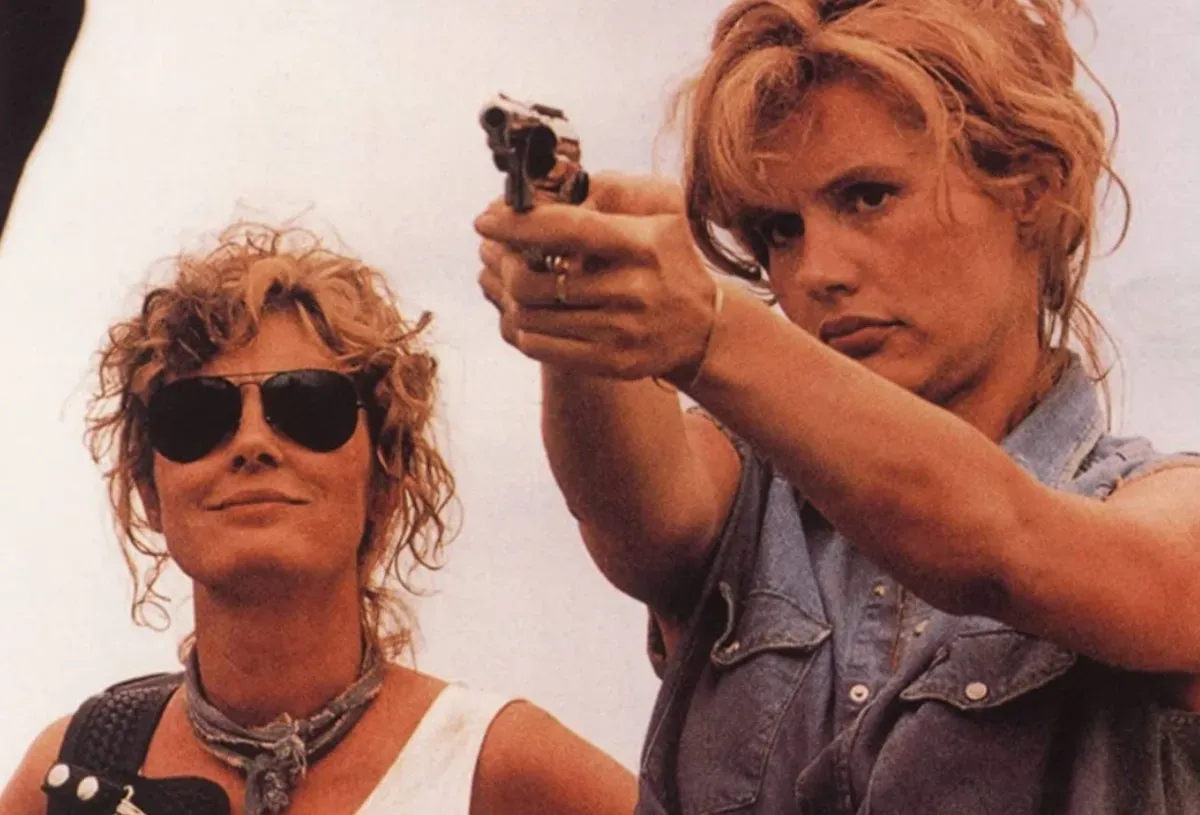THELMA AND LOUISE: A STUDY OF NARRATIVE

‘A courageous and controversial film that both reflects and challenges the conventions of the Hollywood film industry of the early 1990’s’This is a subtitle for your new post
Released in 1991, Thelma and Louise, directed by Ridley-Scott, received six Oscar nominations, Callie Khouri winning the Oscar for best screenplay. In this seminar paper I consider issues of narrative structure, character and perspective and review its context within wider society.
We join the story in medias res as two ordinary women from a small American town, Thelma a submissive housewife and Louise a self–sufficient waitress with boyfriend issues, prepare to leave for a weekend away on their own. Thelma packs her husband’s gun foreshadowing later events. They stop at a roadhouse where Louise kills Harlan Puckett, a man who attempts to rape Thelma after dancing with her. They flee, fearing the police won’t believe them. Thelma borrows money from her boyfriend, Jimmy Lennox, later stolen by a hitchhiker, JD. Their status as outlaws is compounded when Thelma robs a liquor store to replace the lost money and fund their escape to Mexico. After overpowering a police patrolman, and blowing up the rig of a trucker who has been harassing them, they are labelled as armed and dangerous. Charged with murder, their options narrow as the police close in. Escape becomes impossible and they choose to die rather than surrender.
A polysemy of Road Movie, Outlaw Movie and Buddy Movie, the film shares the conventions of these genres with Easy Rider (1969) and Butch Cassidy and the Sundance kid (1969). The similarities can be seen in both the Fabula: two friends on a rebellious journey, challenging authority and paying the price, and in the Syuzhet : soundtrack of found music, scenic landscapes, linear narration and third party omniscient point of view. It counters and subverts the genre conventions of these earlier films, however by having two female protagonists wreaking violence on men. The film’s release in 1991 coincided with the emergence of feminism from the 1980’s in a fractured state (Sturken, 2000, p11) and a year of headlines devoted to sexual harassment and date or acquaintance rape (Budszin,1995). It challenges traditional character types and the “grammar of social scripts” (Marcus cited in Budszin,1995) and reflects changing attitudes to women in the 1990’s. Cited as a beacon of the feminist movement ever since, Raina Lipsitz’s 2011 review in The Atlantic) called it ‘The last great film about women’ (Lipsitz, 2011). However, Screenwriter Callie Khouri argued that it was not a film about feminism but about outlaws (Screenprism, 2016).
Visual paradigms of the Western Genre become evident, as the mise en scene reveals images of cattle drives and frontier landscapes and the protagonist adopt cowboy-influenced dress. Comedic elements are apparent in the dialogue, situations and supporting characters, including Thelma’s scripted hold up of the liquor store, confronting the truck driver and the behaviour of Thelma’s husband, Darryl. The conventions of a Rape Revenge Movie are displayed when Louise shoots Harlan, although he is no longer a threat. Tragedy, reminiscent of films like Sophie’s Choice (1979), in which the main character could not live with a choice she had been forced to make and committed suicide. Thelma and Louise choose to die because they cannot live with the thought of a life of incarceration.
This Heterodiegetic narration allows the audience to witness the comedic antics of Thelma’s husband Darryl and reveals the character of Hal Slocum and his sympathy for the fugitives. It also adds poignancy to the scenes that build towards the climax. As Thelma dreams of a future in Mexico, a ‘We could change our names…We can live in a hacienda’ Thelma and Louise (Ridley Scott, 1991, 110 mins), the audience knows the police are already closing in.
Compared with the more disruptive and non-linear narrative, multiple story lines and points of view employed in the neo-noir comedy Pulp Fiction (QuentinTarantino,1994), the linear structure, a convention of the Road Movie, allows the audience to consider the themes and questions raised as the story unfolds.
The plausibility of the plot is carried by a strong diegesis, each scene or sequence having a causal relationship with the last. Even the final act seems inevitable, given an alternative life of incarceration and is symbolic of continuing their quest for freedom and a better life. In Thelma’s case, the meaning is even more profound. ‘Something’s crossed over in me… I can’t go back.’ Thelma and Louise (Ridley Scott, 1991, 125 mins).
The representation of story time (3-4 days) is converted into the discourse time (130 Minutes) by focussing on scenes that are significant to the plot, the resultant ellipsis being implicit rather than explicit (Gennette, 1989). For example, they set off in bright sunshine and in the next scene night is falling. The audience can infer from this that time has passed and distance travelled.
The film is paced with sequences of action that demand close attention, interposed with calmer scenes that give the audience breathing space to review, speculate, and contemplate the wider issues raised. These include concepts of right and wrong; justification for violence and law breaking; revenge and retribution, and issues surrounding misogyny, the objectification of women, empowerment of women and women’s role in American society.
The non-diegetic sounds of the found music soundtrack support the narrative, including Marianne Faithful’s rendition of The ballad of Lucy Jordan, Thelma and Louise (Ridley- Scott, 1991), reflecting their dreams of a better life: BB King’s, Better Not Look Down (ibid) provides helpful advice as they plunge over cliff.
The main antagonist could be considered to be American patriarchal society and everything it represents, characterised by the oppressive presence of the FBI and largely Flat (Forster et al., 2005) stereotypical male characters, including Harlan, Darryl, the truck driver and the traffic cop. Perversely, Hal, the policeman who is pursuing them, is more rounded demonstrating his capacity for change and not representative of this stereotype. Although charged with capturing them, he has sympathy for their plight, finally attempting to save them.
Thelma’s character has the most significant arc, transformed by her journey from a submissive housewife to an empowered and confident woman. Louise, confident and efficient at the beginning, remains much the same at the end, but changes throughout the film, at times showing her vulnerability, which allows Thelma to step in and assert herself.
There is some evidence to suggest that the film follows the conventions of the Three Act Structure popular in Hollywood at the time and advocated by Syd Fields in The Screenwriter’s Workbook (1987). The timings of the inciting incident at the roadhouse at 21 minutes, the midpoint, when Thelma robs the liquor store at 71 minutes, fitting exactly to the conventions of The Three Act structure. However, the climax commencing at 113 minutes is followed by a relatively short Act 3 of 17 minutes, which also reflects the theories of neo-formalists like Robert McKee who sites the film in his book, Story (1997). Other Formalist and Neo-Formalist conventions are also evident including the concept of Quest as they strive for freedom, and ‘crisis in climax’ (ibid) as suspense is created when the two protagonists hesitate before making the final fatal decision. Published in 1997, McKee’s, Story could not have had a direct influence on Khouri, but the formalist theories of Vladimir Propp (2015), based on his study of Russian folk tales, can be identified in many of the functions, and character types. However, the film challenges these conventions by constantly switching roles. For example, Louise is the Princess and Thelma as the hero in the liquor store sequence, whereas, in the earlier roadhouse sequence, Thelma is the Princess who needs saving from Harlan, the False Hero and Villain by Thelma, the Hero and Father aided by Darryl, the Helper and Donor of the gun. The roadhouse sequence also reflects how the Structuralists Theories of Tzvetan Todorov can be applied to the film demonstrating the conventions of Equilibrium, Disruption, Recognition of Disruption and Resolution. (Todorov T, et al.,1973).
We can also draw comparisons to the Monomyth described in Hero with a Thousand Faces (Campbell 1972) and made popular in the 1990’s by Christopher Vogler in The Writers Journey (Vogler and Montez, 2007). If we consider Thelma, to be the Hero, and Louise as her Mentor, we can then slot other characters into their respective role including JD as the Shape Shifter. The Star Wars movies, produced by George Lucas, are more closely associated with the Monomyth theory (Kline 1999).
The linear narration also displays conventions of the Greek and Roman based Five Act Structure. The weekend away is disrupted by the assault on Thelma and the death of Harlan. There follows several turning points as they try and escape pursuit before the climax when they are cornered. Resolution comes with them choosing death to incarceration and Epiphany follows when we realise the profound choice they made when faced with the wrath of the patriarchal society they challenged. Freyteg’s Triangle (1983) a more recent development of this narrative concept could be considered relevant in the context of the protagonist failing fortunes culminating in a final tragedy.
Appearing to both support and subvert any or all of these concepts, the film gives credence to critics of singular rigid narrative theories including James Bonnet who, in his book Stealing Fire from the Gods, maintains they attempt to provide one single answer rather than a part of the whole. ‘Their thinking becomes polarised….The result is a large number of one-sided, incomplete and faulty story models’ (Bonnet,1999, p6). He suggests that all great stories have hidden patterns that can be revealed by following his concept of the Storywheel (ibid).
Thelma and Louise is a courageous and controversial film that both reflects and challenges the conventions of the Hollywood film industry of the early 1990’s, both supports and subverts conventional theories of genre and narrative structure and addresses themes within wider society that still resonate today. As such, it represents a significant contribution to the Hollywood cannon.
.............................................
REFERENCE LIST
Bonnet, J. (1999) Stealing fire from the gods: A dynamic new story model for writers and filmmakers. United States: Michael Wiese Productions. P6.
Kline, S (1999) George Lucas: Interviews. Mississippi: University Press of Mississippi.
Lipsitz, R. (2011) ‘Thelma & Louise’: The last great film about women. Available at: http://www.theatlantic.com/entertainment/archive/2011/08/thelma-louise-the-last-great-film-about-women/244336/ (Accessed: 15 October 2016).
ScreenPrism (2016) Why Thelma and Louise is a historically significant film for feminism. Available at: http://screenprism.com/insights/article/how-does-the-movie-thelma-louise-display-a-connection-to-feminist-film-theo (Accessed: 15 October 2016).
Sturken, M. (2000) ‘Thelma and Louise’. London: British Film Institute.p11
Thelma & Louise (Ridley Scott, 1991). Pathé Entertainment, Percy Main, Star Partners III Ltd. 130 mins.
Todorov, T., Translated, R.H., Todorov, P.T. and Howard, R. (1973) The fantastic: A structural approach to a literary genre. Cleveland: Cleveland, Press of Case Western Reserve University, 1973.
Vogler, C. and Montez, M. (2007) The writer’s journey: Mythic structure for writers. 3rd edn. United States: Wiese, Michael Productions.
BIBLIOGRAPHY
Abbott, P.H. (2008) The Cambridge introduction to narrative. 2nd edn. Cambridge: Cambridge University Press.
Bonnet, J. (1999) Stealing fire from the gods: A dynamic new story model for writers and filmmakers. United States: Michael Wiese Productions. P6.
Bundtzen, L.K. (1995) ‘Thelma and Louise: A story not to be believed’, The Communication Review, 1(2), pp. 179–200. doi: 10.1080/10714429509388258.
Campbell, J. (1972) The hero with a thousand faces. Princeton, NJ, United States: Princeton University Press.
Cobley, P. (2001) Narrative. New York: Taylor & Francis.
Cook, B. (2007) Thelma & Louise Live!: The cultural Afterlife of an American film. Austin, TX, United States: University of Texas Press.
Dimare, P.C. (ed.) (2011) Movies in American history: An encyclopaedia: An encyclopaedia. Santa Barbara, CA: ABC-CLIO.
Field, S. (1987) The screenwriter’s workbook. New York, NY: Bantam Doubleday Dell Publishing Group.
Forster, E.M., Stallybrass, O. and Kermode, F. (2005) Aspects of the novel (Penguin classics). London: Penguin Classics.
Fournier, G. (2006) ‘Thelma and Louise’ and women in Hollywood. New York, NY, United States: McFarland & Company, Incorporated Publishers.
Genette, G. and Lewin, J.E. (1989) Narrative discourse revisited. Baltimore, MD, United States: Cornell University Press.
Khour, C. (1990) Thelma and Louise: Final shooting script. Available at: http://www.dailyscript.com/scripts/thelmaandlouise.html (Accessed: 16 October 2016).
Kline, S (1999) George Lucas: Interviews. Mississippi: University Press of Mississippi.
Kostopoulos, A Welky, D., Mintz, S. and Roberts, R.W. (2016) Hollywood’s America: Understanding history through film. United States: John Wiley & Sons.
Lipsitz, R. (2011) ‘Thelma & Louise’: The last great film about women. Available at: http://www.theatlantic.com/entertainment/archive/2011/08/thelma-louise-the-last-great-film-about-women/244336/ (Accessed: 15 October 2016).
McKee, R. (1997) Story: Substance, structure, style, and the principles of screenwriting. New York: HarperCollins Publishers.
Prince, G. (2003) A dictionary of narratology. Lincoln, NE: University of Nebraska Press.
Propp, V. (2015) Morphology of the Folktale. United States: Martino Fine Books.
ScreenPrism (2016) Why Thelma and Louise is a historically significant film for feminism. Available at: http://screenprism.com/insights/article/how-does-the-movie-thelma-louise-display-a-connection-to-feminist-film-theo (Accessed: 15 October 2016).
Sturken, M. (2000) ‘Thelma and Louise’. London: British Film Institute, p11.
Pulp Fiction (Quentin Tarantino, 1994) Miramax, A Band Apart, Jersey Films. 154 mins.
Thelma & Louise (Ridley Scott, 1991). Pathé Entertainment, Percy Main, Star Partners III Ltd. 130 mins.
Thelma & Louise: Three-Act structure (no date) Available at: http://www.elementsofcinema.com/feature/Thelma_and_Louise/3-act_structure_thelma.html (Accessed: 16 October 2016).
Todorov, T., Translated, R.H., Todorov, P.T. and Howard, R. (1973) The fantastic: A structural approach to a literary genre. Cleveland: Cleveland, Press of Case Western Reserve University, 1973.
Vogler, C. and Montez, M. (2007) The writer’s journey: Mythic structure for writers. 3rd edn. United States: Wiese, Michael Productions.The body content of your post goes here. To edit this text, click on it and delete this default text and start typing your own or paste your own from a different source.


